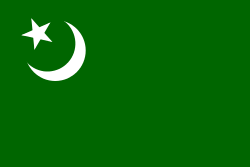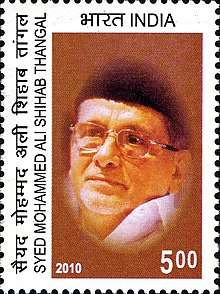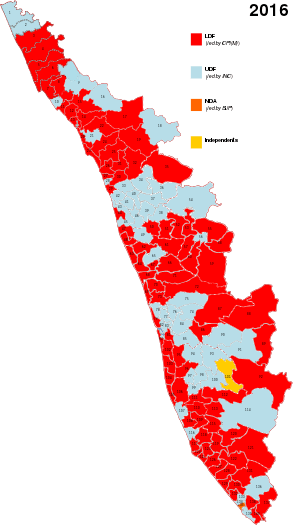Indian Union Muslim League
The Indian Union Muslim League or I. U. M. L. (commonly referred to as the League inside Kerala) is a centre-right political party in India. It is recognized by the Election Commission of India as a State Party in Kerala.
Indian Union Muslim League | |
|---|---|
 | |
| Abbreviation | I. U. M. L (the League) |
| President | K. M. Kader Mohideen |
| Chairperson | Sayed Hyderali Shihab Thangal |
| Secretary | P. K. Kunhalikutty |
| Lok Sabha leader | E. T. Muhammed Basheer |
| Rajya Sabha leader | P. V. Abdul Wahab |
| Founder | Muhammad Ismail |
| Founded | 10 March 1948 |
| Headquarters | Quaid-e-Millath Manzil, No. 36, Maraikayar Lebbai Street, Chennai, Tamil Nadu, India.[1] |
| Newspaper | (see below)
|
| Student wing | Muslim Students Federation (M. S. F.) |
| Youth wing | Muslim Youth League (the Youth League) |
| Women's wing | Indian Union Women's League |
| Labour wing | Swathanthra Trade Union (Kerala) |
| Peasant's wing | Swathanthra Karshaka Sangam (Kerala) |
| Political position | Centre-right |
| Slogan | Unity is Strength |
| Alliance |
|
| Seats in Lok Sabha | 3 / 543 |
| Seats in Rajya Sabha | 1 / 245 |
| Seats in Kerala Legislative Assembly | 18 / 140 |
| Seats in Tamil Nadu Legislative Assembly | 1 / 234 |
| Election symbol | |
 | |
| Website | |
| Twitter Handle | |
Indian Union Muslim League was formed in March, 1948 at the south Indian city of Madras (now Chennai).[2] The party is a major member of the opposition United Democratic Front, the Indian National Congress lead pre-poll state level alliance in Kerala.[3][4] Whenever the United Democratic Front rules in Kerala, the party leaders are chosen as important Cabinet Ministers. The party has always had a constant, if small presence, in the Indian Parliament.[3] The party is a part of the United Progressive Alliance in national level.[3] The League first gained a ministry (Minister of State for External Affairs) in Indian Government in 2004.[5]
The party currently has four members in Parliament (P. K. Kunhalikutty, E. T. Mohammed Basheer, and K. Navas Kani in the Lower House and P. V. Abdul Wahab in the Upper House) and nineteen members in State Legislative Assemblies (Kerala and Tamil Nadu).
History
.png)
After the partition of India in 1947, the All-India Muslim League was disbanded. It was succeeded by the Indian Union Muslim League in the new India (March, 1948).[3] M. Muhammad Ismail, the then President of the Madras Muslim League (M. M. L.) was chosen as the Convener of the Indian section of the League.[2]
The party contests Indian General Elections under the Indian Constitution. B. Pocker, elected from Malappuram Constituency, was a member of the First Lower House (1952–57) from the Madras Muslim League (M. M. L.).[3] The Travancore League (the States' Muslim League) was merged with the Malabar League in November, 1956.[2]
The party is normally represented by two members in the Indian Lower House (the Lok Sabha).[3] The party currently has four members in Parliament.
Indian Union Muslim League first gained a ministry in Kerala Government as part of the Communist Party of India Marxist-led United Front in 1967. The party switched fronts in 1969 and formed an alliance with the Congress in 1976.[6][4] It later became a chief constituent in a succession of Indian National Congress-lead ministries.[4] Apart from Kerala and West Bengal, the League had Legislative Assembly members in Tamil Nadu, Pondicherry, Maharastra, Karanataka, Uttar Pradesh, and Assam.[7] In West Bengal, the League had won Assembly seats in the 1970s, and A. K. A. Hassanussaman was a member of the Ajoy Mukherjee cabinet.[8]
Early years
- Indian Union Muslim League formed in March, 1948 at the south Indian city of Madras (now Chennai).[2]
- B. Pocker Sahib, elected from Malappuram Constituency, was a member of the first Lok Sabha (1952–57).[3]
- K. M Seethi Sahib served as the Speaker of the Kerala Assemby from 1960 to 1961.[9]
- M. Muhammad Ismail offered to send his son to join the Indian army to fight the war against China.[10]
From the 1960s to the 80s
- The League gained a ministry in Kerala Government in 1967 (C. H. Mohammed Koya and M. P. M. Ahammed Kurikkal).[4]
- The League oversaw the creation of the University of Calicut, the second university in Keala, in 1968.[4]
- Contribution to local government - the League oversaw the creation of Malappuram District in 1969.[4]
- Death of M. Muhammad Ismail (1972) and Bafaqy Thangal (1973).[11] Syed Ummer Bafaqy Thangal rebels agains the leadership.[11]
With the Congress Party
- Muslim League formed an alliance with the Congress in 1976.[6]
- C. H. Mohammed Koya served as the Chief Minister of Kerala from 12 October to 1 December 1979.[12]
- The 'rebel' Muslim League formed 'All India Muslim League' and joined the Left Front in 1980.[11][13]
- C. H. Mohammed Koya and K. Avukaderkutty Naha served as Deputy Chief Ministers Of Kerala in the 1980s.[14]
In the 1990s
- All India Muslim League (AIML) quit the Left Front and merged with the Muslim League in 1985.[15]
- Demolition of the Babri Masjid (1992). Panakkad Syed Mohammed Ali Shihab Thangal made a passionate plea to all the Muslims in Kerala to remain calm.[16] Kerala remained peaceful throughout.[10]
- Ebrahim Sulaiman Sait, then National President, rebelled and formed the Indian National League (INL) in 1994.[17]
- Minister of Education (E. T. Mohammad Basheer) decided to establish the University of Sanskrit (1994) in Kerala.[17]
From the 2000s
- Atal Bihari Vajpayee dispatched E. Ahamed to the United Nations (Geneva) to represent India (2004).[17][10]
- Mid-2000s witnessed the Manjeri (2004) and the Kuttippuram-Mankada (2006) defeats.[18]
- The League first gained a ministry (E. Ahamed) in Indian Government (Manmohan Singh Ministry) in 2004.[5]
- Panakkad Syed Mohammed Ali Shihab Thangal passed away in 2009.[16]
- The League won a record 20 out the constested 23 seats in the 2011 Assembly Elections.
Ideology
The [Indian Union Muslim League] party...has shown strands of identity politics, but largely remained communitarian; it has at times been conservative, but never communal. It has furthered Muslim aspirations without antagonising any other segment—and hence has retained its centrality in the larger Kerala polity
The distinctive feature of the [Indian Union] Muslim League in Kerala is that it strove to keep the [Muslim] community at the centre of the [Kerala] state's politics, unlike other Muslim political formations elsewhere in India that revelled in confessional isolationism. As a result, the Kerala Muslims emerged as probably the only community of that faith in India that achieved genuine political empowerment on the one hand and, on the other, lived out the promise of equal citizenship enshrined in the [Indian] Constitution.
If organising a religious community politically on the basis of antagonism to another is communalism, the IUML has never mobilised its cadre nor used its political and often administrative clout to create religious divides. On the contrary, whenever the state faced a communally sensitive situation, the party rose to the occasion and played a stellar role in dousing the flames....By practicing a brand of politics that could be termed communitarian rather than communal, the IUML succeeded in actualising the constitutional guarantee of equal citizenship for the Muslims in the state.
Composition


| Designation | Name |
|---|---|
| Chairman-Political Advisory | Sayed Hyderali Shihab Thangal (Kerala)[19] |
| National President | K. M. Kader Mohideen (Tamil Nadu)[20] |
| Vice-Presidents | Iqbal Ahmed (Uttar Pradesh) |
| Dastagir Ibrahim Aga (Karnataka) | |
| National General Secretary | P. K. Kunhalikutty (Kerala)[21] |
| National Organising Secretary | E. T. Mohammed Basheer (Kerala) |
| National Treasurer | P. V. Abdul Wahab (Kerala)[22] |
| Secretaries | Khorrum Anis Omer (Delhi) |
| M. P. Abdussamad Samadani (Kerala) | |
| S. Naim Akthar (Bihar) | |
| Siraj Ebrahim Sait (Karnataka) | |
| Assistant Secretaries | Abdul Basith (Tamil Nadu) |
| Kausar Hayat Khan (Uttar Pradesh) |
Organizational structure
- Youth Wing: Muslim Youth League (the Youth League)
- National President: Sabir S. Gaffar (West Bangal)
- Kerala State General Secretary: P. K. Firoz
- Kerala State President: Syed Munawar Ali Shihab Thangal
- National Secretary: C. K. Subair (Kerala)
- Students' Wing: Muslim Students Federation (M. S. F.)
- National President: T. P. Ashrafali
- National General Secretary: S. H. Muhammed Arshad
- Women's Political Wing: Muslim Women's League
- Trade Union Organization (Kerala): Swathanthra Thozhilali Union (S. T. U., Independent Workers Union)
- Peasants' Union (Kerala): Swathanthra Karshaka Sangam (Independent Peasants Union)
- Advocates: Lawyers Forum
- Expatriates: Kerala Muslim Cultural Centre (K. M. C. C.)
Kerala Legislative Assembly
Source: http://www.ceo.kerala.gov.in/electionhistory.html
| Election | Seats | Vote % | Government/Opposition | Ministers | Ruling Coalition/Front |
|---|---|---|---|---|---|
| Won (Contested) | |||||
| 1957 | 7 or 8 (as independents)[23][13] | Opposition (to Namboodiripad Ministry)
1957 - 59 |
PSP-League alliance[13] | ||
| 1960 | 11[24] (12) | 4.96 | Government[24] (Pattom Ministry)
1960 - 62
|
Excluded from the Pattom Ministry[24] | Congress-PSP-League
(or) Joint Front[25] |
| Abstaining Opposition (to Shankar Ministry)[24]
1962 - 64 |
No coalition[24] | ||||
| 1965 | 6 (16) | 3.83 | Inconclusive (no government formed)[24] | United Left Front[25](CPIM-League alliance)[13] | |
| 1967 | 14 (15) | 6.75 | Government[4] (Namboodiripad Ministry)
1967 - 69 |
|
United Front[4]
(Seven Party Alliance) (or) United Left Front[25] |
| Government (Achutha Menon Ministry)
1969 - 70 |
Mini Front[26] | ||||
| 1970 | 11 (20) | 7.56 | Government (Achutha Menon Ministry)
1970 - 77 |
|
Mini/Maxi Front[26](or)
United Front[27] |
| 1977 | 13 (16) | 6.66 | Government (Karunakaran Ministry)
1977 |
Maxi Front
(revamped)[26] (or) United Front[27] | |
| Government (Antony Ministry)
1977 - 78 |
| ||||
| Government (PKV Ministry)
1978 - 79 |
|||||
| Government (Koya Ministry)
1979 |
|||||
| 1980 | 14 (21) | 7.18 | Opposition (to Nayanar Ministry)
1980 - 81 |
UDF[4] | |
| Government (Karunakaran Ministry)
1981 - 82 |
|||||
| 1982 | 14 (18) | 6.17 | Government (Karunakaran Ministry)
1982 - 87 |
| |
| 1987 | 15 (23) | 7.73 | Opposition
(to Nayanar Ministry) 1987 - 91 | ||
| 1991 | 19 (22) | 7.37 | Government
(Karunakaran Ministry) 1991 - 95 |
| |
| Government
(Antony Ministry) 1995 - 96 |
| ||||
| 1996 | 13 (22) | 7.19 | Opposition
(to Nayanar Ministry) 1996 - 2001 | ||
| 2001 | 16 (21) | 7.59 | Government
(Antony Ministry) 2001 - 2004 |
| |
| Government
(Chandy Ministry) 2004 - 2006 |
| ||||
| 2006 | 7 (21) | 7.30 | Opposition
(to Achuthanandan Ministry) 2006 - 11 | ||
| 2011 | 20 (23) | 7.92 | Government
(Chandy Ministry) 2011 - 16 |
||
| 2016 | 18 (23) | 7.40 | Opposition
(to Vijayan Ministry) 2016 - present | ||
Current members

Members in Indian Parliament
Lower House (the Lok Sabha)
Source: Loksabha
- 1st House
- B. Pocker (Malappuram)
- 2nd House - No members
- B. Pocker (Manjeri) - independent
- 3rd House
- C. H. Mohammed Koya (Kozhikode)
- M. Muhammad Ismail (Manjeri)
- 4th House
- M. Muhammad Ismail (Manjeri)
- Ebrahim Sulaiman Sait (Kozhikode)
- S. M. Muhammed Sheriff (Ramanathapuram)
- 5th House
- M. Muhammad Ismail (Manjeri)
- Ebrahim Sulaiman Sait (Kozhikode)
- S. M. Muhammed Sheriff (Periyakulam)
- Abu Taleb Chowdhury (Murshidabad) - independent
- 6th-9th Houses
- G. M. Banatwalla (Ponnani)
- Ebrahim Sulaiman Sait (Manjeri)
- 10th House
- Ebrahim Sulaiman Sait (Ponnani)
- E. Ahamed (Manjeri)
- 11th-13th Houses
- G. M. Banatwalla (Ponnani)
- E. Ahamed (Manjeri)
- 14th House
- 15th House
- E. Ahamed (Malappuram) as Union Minister of State[5]
- E. T. Mohammed Basheer (Ponnani)
- 16th House
- E. Ahamed and P. K. Kunhalikutty (Malappuram)
- E. T. Mohammed Basheer (Ponnani)
- 17th House
- P. K. Kunhalikutty (Malappuram)
- E. T. Mohammed Basheer (Ponnani)
- K. Navas Kani (Ramanathapuram)
Council of States (the Rajya Sabha)
Source: Rajyasabha
- M. Muhammad Ismail (1952–58) - independent
Kerala
- Ebrahim Sulaiman Sait (1960–66)
- Abdulla Koya (1967–73, 1974–98)
- Hamid Ali Schamnad (1970–79)
- Abdussamad Samadani (1994–2006)
- Korambayil Ahammed (1998–03)
- P. V. Abdul Wahab (2004–10, 2015–21)
Tamil Nadu
- A. K. A. Abdul Samad (1964–70)
- S. A. Khwaja Mohideen (1968–74)
- A. K. A. Abdul Samad (1970– 76)
- A. K. Refaye (1972–78)
- S. A. Khwaja Mohideen (1974-80)
References
- "List of Political Parties and Election Symbols main Notification Dated 18.01.2013" (PDF). India: Election Commission of India. 2013. Retrieved 9 May 2013.
- Wright, T. (1966). The Muslim League in South India since Independence: A Study in Minority Group Political Strategies. The American Political Science Review, 60(3), 579-599.
- "Explained: History of Muslim League in Kerala and India". The Indian Express. 6 April 2019. Retrieved 4 August 2019.
- James Chiriyankandath (1996) Changing Muslim politics in Kerala: identity, interests and political strategies, Journal of Muslim Minority Affairs, 16:2, 257-271.
- Press Trust of India (19 June 2004). "E. Ahamed: Minister of State for External Affairs". Hindustan Times. Retrieved 7 June 2020.
- Menon, Girish (22 March 2016). "How the Muslim League is at peace with itself". The Hindu. Trivandrum.
- "History of Indian Union Muslim League". Indian Union Muslim League (website).
- Ameerudheen, T. A. (21 May 2017). "Will the Muslim League's decision to go national affect Asaduddin Owaisi plans for his party?". Scroll. Archived from the original on 12 June 2020.
- "SPEAKERS AND DEPUTY SPEAKERS OF KERALA LEGISLATIVE ASSEMBLY" (PDF). Kerala Legislative Assembly. Trivandrum: Secretariat of the Kerala Legislature. 2007.
- Nair, Preetha (19 April 2019). "A Coloured Scheme Of Things". Outlook.
- Wright (23 June 1948). "Muslims and the 1977 Indian Elections: A Watershed?". Asian Survey. 17 (12): 1207–1220. doi:10.2307/2643422. ISSN 0004-4687.
- Chief Minister of Kerala (Official Website)
- Radhakrishnan, M. G. (19 April 2019). "Revenge of the Dead Horse". Asianet News. Trivandrum.
- Chief Minister of Kerala (Official Website)
- Pillai, Sreedhar (31 August 1985). "Indian Union Muslim League and All India Muslim League merge in Kerala". India Today. Kerala.
- IANS (2 August 2009). "Kerala mourns passing away of Panakkad Thangal". Gulf News. Malappuram.
- Madampat, Shajahan (11 April 2019). "The importance of IUML". The Indian Express. Archived from the original on 12 June 2020. Retrieved 12 June 2020.
- Naha, Abdul Latheef (25 March 2014). "Muslim votes not a monolithic bloc". The Hindu. Malappuram. Retrieved 6 June 2020.
- "Hyderali Shihab Thangal, chief of IUML in Kerala". The Hindu. 15 August 2009. Retrieved 25 October 2009.
- "K M Khader Mohideen is IUML National President". India Today. Retrieved 16 September 2018.
- "P K Kunhalikutty is IUML national general secretary - Times of India". The Times of India. Retrieved 16 September 2018.
- "Indian Union Muslim League national committee members". iuml.com. Retrieved 26 January 2019.
- Jeffrey, Robin. "Politics, Women and Well-Being: How Kerala became a Model" Palgrave McMillan (1992); 112 and 114.
- Wright, Theodore P. 'The Muslim League in South India since Independence.' American Political Science Review, vol. 60, no. 3, 1966, pp. 579–599., doi:10.2307/1952972.
- Malhotra, Inder. "The eternal Kerala pattern". The Indian Express.
- Nossiter, Thomas Johnson (1982). Communism in Kerala: A Study in Political Adaptation. Berkeley and Los Angeles: University of California Press. pp. 5–6.
- Kartha, G. S. (15 May 1977). "Kerala seems to be drifting towards instability". India Today.
External links
![]()